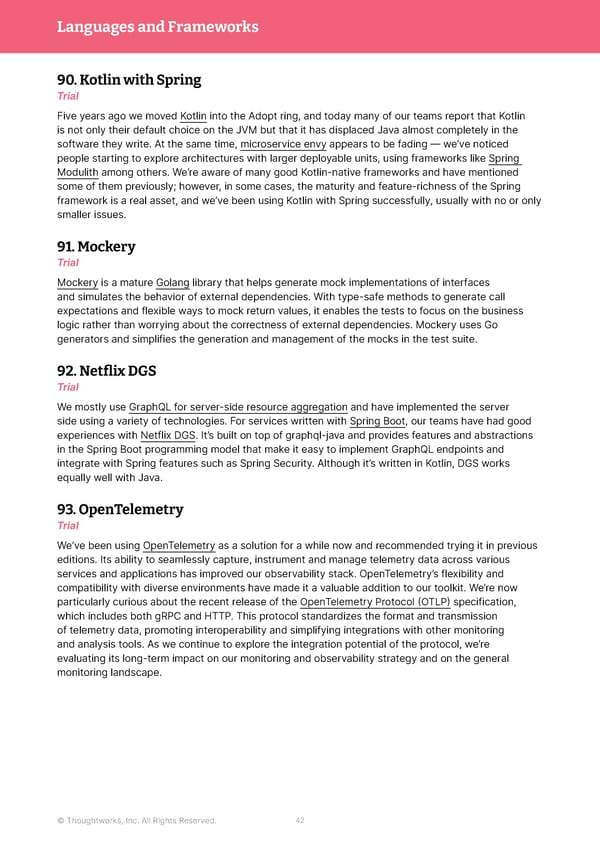Languages and Frameworks 90. Kotlin with Spring Trial Five years ago we moved Kotlin into the Adopt ring, and today many of our teams report that Kotlin is not only their default choice on the JVM but that it has displaced Java almost completely in the software they write. At the same time, microservice envy appears to be fading — we’ve noticed people starting to explore architectures with larger deployable units, using frameworks like Spring Modulith among others. We’re aware of many good Kotlin-native frameworks and have mentioned some of them previously; however, in some cases, the maturity and feature-richness of the Spring framework is a real asset, and we’ve been using Kotlin with Spring successfully, usually with no or only smaller issues. 91. Mockery Trial Mockery is a mature Golang library that helps generate mock implementations of interfaces and simulates the behavior of external dependencies. With type-safe methods to generate call expectations and flexible ways to mock return values, it enables the tests to focus on the business logic rather than worrying about the correctness of external dependencies. Mockery uses Go generators and simplifies the generation and management of the mocks in the test suite. 92. Net昀氀ix DGS Trial We mostly use GraphQL for server-side resource aggregation and have implemented the server side using a variety of technologies. For services written with Spring Boot, our teams have had good experiences with Netflix DGS. It’s built on top of graphql-java and provides features and abstractions in the Spring Boot programming model that make it easy to implement GraphQL endpoints and integrate with Spring features such as Spring Security. Although it’s written in Kotlin, DGS works equally well with Java. 93. OpenTelemetry Trial We’ve been using OpenTelemetry as a solution for a while now and recommended trying it in previous editions. Its ability to seamlessly capture, instrument and manage telemetry data across various services and applications has improved our observability stack. OpenTelemetry’s flexibility and compatibility with diverse environments have made it a valuable addition to our toolkit. We’re now particularly curious about the recent release of the OpenTelemetry Protocol (OTLP) specification, which includes both gRPC and HTTP. This protocol standardizes the format and transmission of telemetry data, promoting interoperability and simplifying integrations with other monitoring and analysis tools. As we continue to explore the integration potential of the protocol, we’re evaluating its long-term impact on our monitoring and observability strategy and on the general monitoring landscape. © Thoughtworks, Inc. All Rights Reserved. 42
 Thoughtworks Technology Radar Page 41 Page 43
Thoughtworks Technology Radar Page 41 Page 43